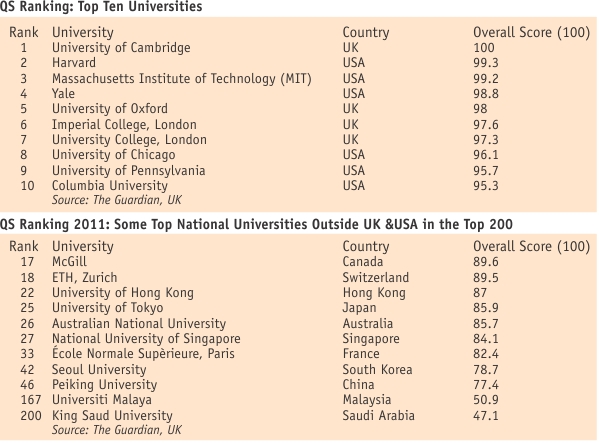Post Campus
The QS World University Ranking, 2011:
Cambridge Tops Again
Asrar Chowdhury
The QS World University Ranking is an annual ranking of the top 500 universities throughout the world. The Quacquarelli Symonds (QS) and the Times Higher Education (THE) of the UK published the rankings from 2004 to 2009. From 2010 Quacquarelli Symonds has been solely publishing the rankings after disagreements arose in the methodology between QS and THE. The need for a ranking of global universities arose after a debate in 2003 to see where UK universities rank in the global spectrum.
The QS Ranking is based on assessing five indicators that receive different weights. The indicators with their assigned weights are:
 |
Cambridge University. PHOTO: INTERNET |
Academic Peer Review (40%) is based on a survey of asking academics across the world structured questions about the top universities in their specialised fields. Recruiter Review (10%) asks similar questions to recruiters who employ graduates on a global scale. The third indicator is the Teachers-Student Ratio (20%). This assesses a university's commitment to teaching. Citations Per Teacher (20%). Citations of published research in academic journals have long been an indicator to assess the individual researcher and the institute from which the research was published. The final indicator is International Orientation (10%). This indicator is broken down into two components: percentage of international students to total students (5%) and percentage of international teachers to local teachers (5%).
The QS Rankings are published under two categories. The first is an overall ranking that seeks to capture the overall best university of the observed year. The second ranking seeks to capture the best universities in specialised fields. These specialised fields include: (a) natural sciences, (b) technology, (c) biology and medicine, (d) social sciences and (e) the arts and humanities.
Cambridge of the UK topped the QS World Rankings for 2011 leaving Harvard of the USA behind by a whisker for a second consecutive year. Cambridge went ahead by a very fine margin on a better teacher-student ratio. This is not surprising. The Oxbridge (Oxford and Cambridge) method of teaching has historically emphasised on superior tutoring in small class-sizes for better monitoring and results.
The Top Ten universities of 2011 were all from the USA and the UK. Cambridge (1); Oxford (5); Imperial (6) and UCL (7) were from the UK. Harvard (2); MIT (3); Yale (4); Chicago (8); Pennsylvania (9); and Columbia (10) were from the USA.
The top national universities in the Top 50 outside the UK and the USA include: McGill, Canada (17); ETH, Zurich (18); University of Hong Kong (87); University of Tokyo, Japan (25); ANU, Australia (26); National University of Singapore (27); École Normale Supèrieure, Paris, France (33); Seoul University, South Korea (42); and Peking University, China (46). This reveals there are good global universities outside the UK and the USA people in Bangladesh and elsewhere tend to overlook.
The University of Malaya from Malaysia obtained position 167. For the first time a Middle East University outside Israel has entered the Top 200 list. This is the King Saud University in Saudi Arabia (200). The most surprising observation- there was not a single university in the Top 200 from South Asia.
The modern university distinguishes itself from learning institutes prior to the 20th century by serving a dual purpose. Modern universities no longer provide teaching and learning only. Today, modern universities produce 'trained' graduates for labour markets. Modern universities also contribute towards extension of human knowledge and experience through research. It is these components that separate today's modern universities from the learning centres of the Middle Ages and the Ancient times. The age of the Guru-Shishya or the Apprenticeship of the Guilds is dead. Thus it is not surprising that teachers-students ratio comprises only 10 percent of the total weight in the QS Ranking.
The biggest challenge for modern universities to maintain quality is the simple question- where will funds come from? Education, Health and Security are the largest components of expenditure for any State. Funding of the above three sectors are sensitive in all socities. In reference to the UK and the US, tuition fees in the top UK universities are much lower than the top US universities. The decision to increase UK university tuition fees from 2012 may have an adverse effect for the UK. UK students may find an incentive to cross the Channel to Continental Europe where there are world-class universities that offer university education at competitive tuition fees and cheaper living standards.
The QS Ranking arose from the needs of the UK society. Post Campus X raises a question. When will there be a widely accepted ranking of Bangladeshi Universities? Asking a question is the first step to moving towards an answer.

Source: Wikipedia and The Guardian, UK
(The author teaches economic theory at Jahangirnagar University and North South University.)
| 